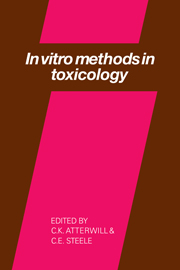Conclusion
Published online by Cambridge University Press: 06 August 2010
Summary
In this book a wide variety of techniques has been described by experts in the various fields and we would now like to outline how they now or in the future might fit into the process of compound development. In general, in vitro models such as these are employed for several reasons. Firstly, to perform mechanistic work of an applied nature in parallel with, and subsequent to, routine in vivo toxicity studies. Secondly, in the commercial environment they are increasingly being used for pre-development screening of potential development compounds. Finally, they have been, and will be, used empirically for obtaining new and fundamental background knowledge on biochemical/cellular toxicology phenomena. This will undoubtedly encompass many of the biotechnological and molecular biology advances and will continue to provide new information and techniques for the practitioners of applied in vitro toxicology.
We have chosen some of the more familiar systems currently used in in vitro toxicology and have taken a different approach from earlier works in that we have concentrated exclusively on viable cell/tissue/organ preparations which maintain functional capacity in vitro. By reference to the topics discussed at recent symposia and in the scientific literature it is evident that there are still other systems to be considered such as gut, bone, smooth muscle etc.
Inevitably this list will expand as technology advances and we look forward to updating and expanding the current volume for later editions.
- Type
- Chapter
- Information
- In Vitro Methods in Toxicology , pp. 443 - 446Publisher: Cambridge University PressPrint publication year: 1987



